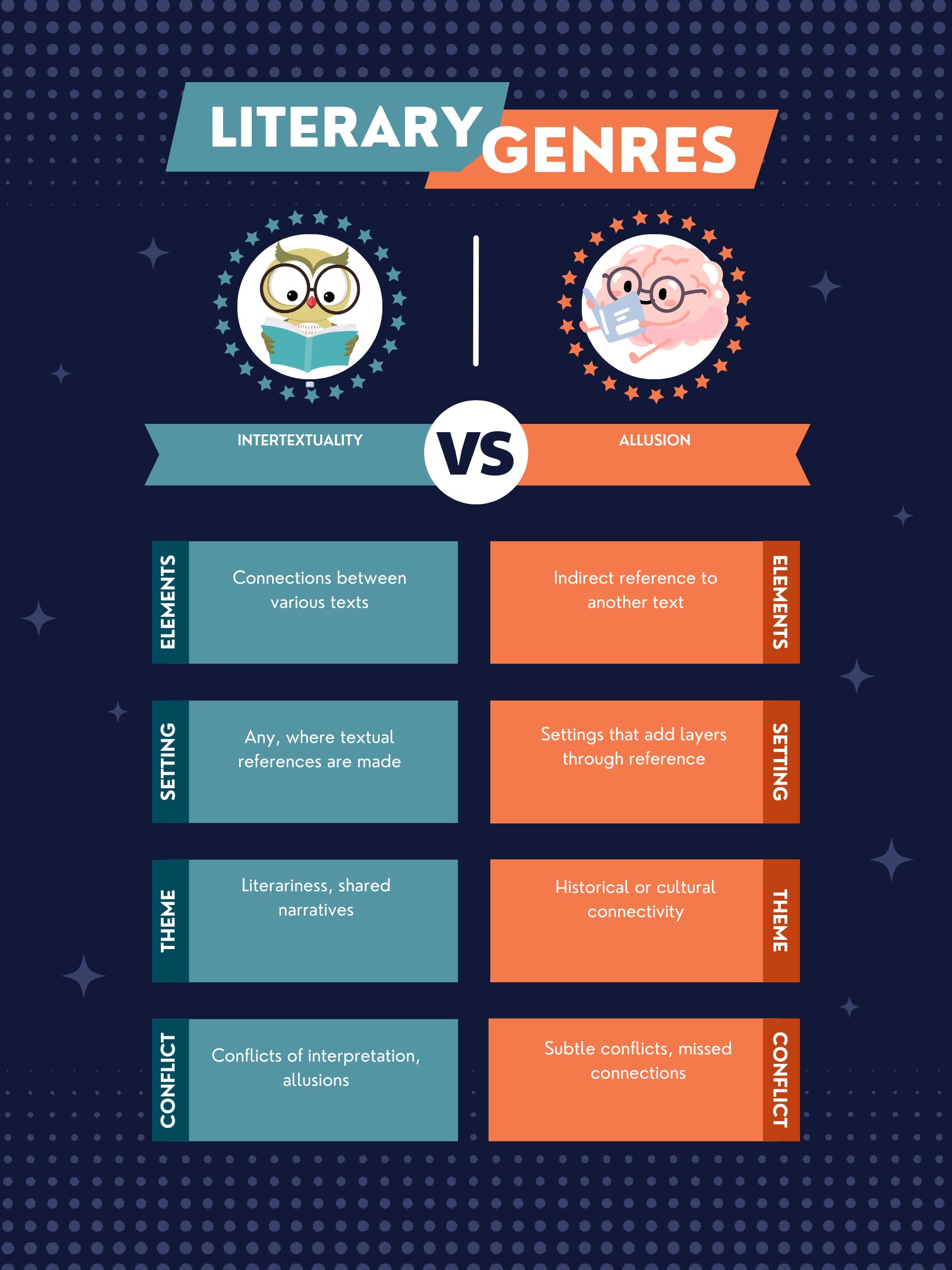Intertextuality is the shaping of a text’s meaning by another text, involving a complex relationship between texts; Allusion is a brief and indirect reference to a person, place, thing, or idea of historical, cultural, literary, or political significance.
Intertextuality
Intertextuality refers to the relationship between texts and how they inform or reshape the meaning of one another. It’s a web of influences, quotations, or direct references from one text to another, creating a layered reading experience.
Example: James Joyce’s Ulysses is renowned for its intertextual references to Homer’s Odyssey, reimagining the epic’s themes and characters in a modern Dublin setting, thus enriching the narrative with deep connections to classical literature.
Allusion
Allusion is a device used to refer indirectly to a well-known person, place, event, literary work, or artwork. This technique enriches the text by invoking the emotional or intellectual associations with the referenced work or figure.
Example: In Martin Luther King Jr.’s “I Have a Dream” speech, he alludes to Shakespeare’s Hamlet (“In a sense we’ve come to our nation’s capital to cash a check…”) to deepen his argument about America’s unfulfilled promises to its citizens.
Summary
| Literary Device | Definition | Purpose | Usage | Relevant Examples |
|---|---|---|---|---|
| Intertextuality | The relationship between texts and how one text influences or shapes the meaning of another. | To create depth, offer critique, or engage with other works in a complex dialogue. | Utilized in works that engage directly with other texts, whether through homage, critique, or extension of themes. | James Joyce’s Ulysses. |
| Allusion | A brief, indirect reference to a well-known figure, event, or work, without detailed explanation. | To enrich text by invoking the associations of the referenced work or figure. | Found in all types of texts, often to add depth or contextualize themes without explicit explanation. | Martin Luther King Jr.’s “I Have a Dream” speech. |
Writing Tips
For writers eager to incorporate Intertextuality or Allusion in their works, consider the following advice:
- Intertextuality: Familiarize yourself with the texts you want to engage with. Think about how these texts can inform or contrast with your work, and use direct references or thematic parallels to create a dialogue between your text and others.
- Allusion: Ensure your references are to widely recognized works or figures to ensure your audience grasps the intended association. Use allusions sparingly and purposefully to enrich your narrative without relying on the reader’s external knowledge for understanding.
FAQs
How do I choose between using Intertextuality and Allusion?
Consider your objective: use Intertextuality for deeper engagement with another text, creating a dialogue between works; opt for Allusion to subtly enrich your narrative with external references.
Can a text have both Intertextuality and Allusion?
Absolutely! Many texts use both devices to create rich, layered narratives that engage with other works while making brief references to enhance meaning or thematic depth.
How can I effectively use Intertextuality without plagiarizing?
Intertextuality is about creating a conversation between texts, not copying. Ensure you’re adding original thought or commentary on the referenced work, showcasing how it informs or contrasts with your narrative.
Exercise
Decide whether the following examples showcase Intertextuality or Allusion:
- A novel’s protagonist named Ahab obsessively pursues a metaphorical white whale, mirroring the narrative of Moby-Dick.
- A poem references “the best-laid plans of mice and men,” invoking Robert Burns’ poem but not elaborating on its themes.
Answers:
- Intertextuality.
- Allusion.
Other Device Comparisons You May Find Interesting
- Metaphor vs Simile: Discover the nuances between these comparative figures of speech.
- Symbolism vs Allegory: Explore how these devices use symbols to convey deeper meanings and tell stories within stories.
- Irony vs Sarcasm: Unravel the subtle differences between these two forms of wit.
- Pathos vs Ethos: Understand the different appeals used to engage an audience emotionally and ethically.
By examining the unique roles of Intertextuality and Allusion, we can appreciate the intricate ways in which texts converse with one another and enrich our understanding of literature. 📖✨

